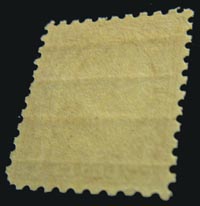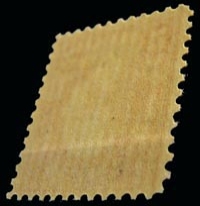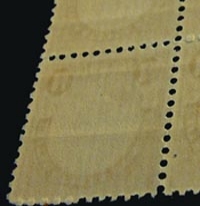Gum Breakers on
U.S. 1922-1935 Stamps
By Bob Allen
The rotary press printing method provided many advantages in the manufacture of U.S. postage stamps, primarily in the speed of production allowing the printing of stamps on rolls of paper rather than on the single sheet at a time of the flat plate method. It also allowed the gumming of stamps as a roll rather than by the individual sheet, again a big time-saver. However, when the rotary press rolls were cut down to sheets to be delivered to post offices, the sheets tended to curl back into their rolled form. This was not a problem with rotary coils which were sold in rolls, but it was a problem for postal clerks who needed the sheets of stamps to lie flat in their drawers. More pressing was the fact that it was exceptionally difficult to add pre-cancels to the curled sheets without tearing the sheets apart at the perforations, a problem that was alleviated somewhat as the Bureau took over the pre-canceling chore. Since un-gummed sheets from the rotary rolls did not curl, it was noted that the gum must be the cause of the curling. By simply adding "breaks" in the gum the curling was reduced considerably. The three1 main types of gum breakers and the numbering system as described by Armstrong are shown in the diagram below.

Type I Gum Breaker 1923(?)-1928
The spacing between the Type I breaker bars is 5.5 mm, allowing between 4 to 5 bars per stamp. This type of gum breaker was used on definitive stamps from possibly as early as 1923 until the end of 1928. The Type II breakers were first introduced in March 1928 to offset the "corrugated" look and feel of the Type I breakers

Type II Gum Breaker 1928-1930
The spacing between the Type II horizontal breaker bars is 22 mm, allowing only one bar per stamp, unless the bars are at the very top and bottom of the stamp, in which case there may be two bars. Note the 14 vertical ridges; all Type II stamps must have these ridges.

Type III Gum Breaker 1930-1960's
The spacing between the Type III breaker bars is 12 mm, allowing between 2 to 3 bars per stamp. The gum on these stamps is slightly glossier and smoother than the gum on the previous types. The Type III breaker wasn't introduced until 1930, which means it can never appear on the Kansas-Nebraska or Hawaii overprints of 1928-29.





